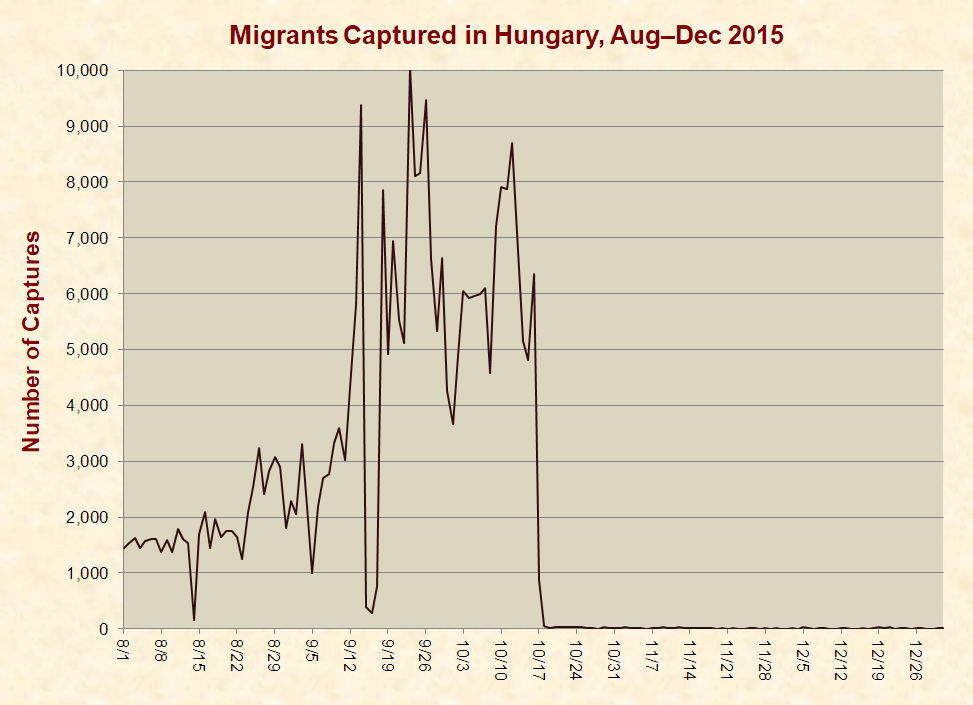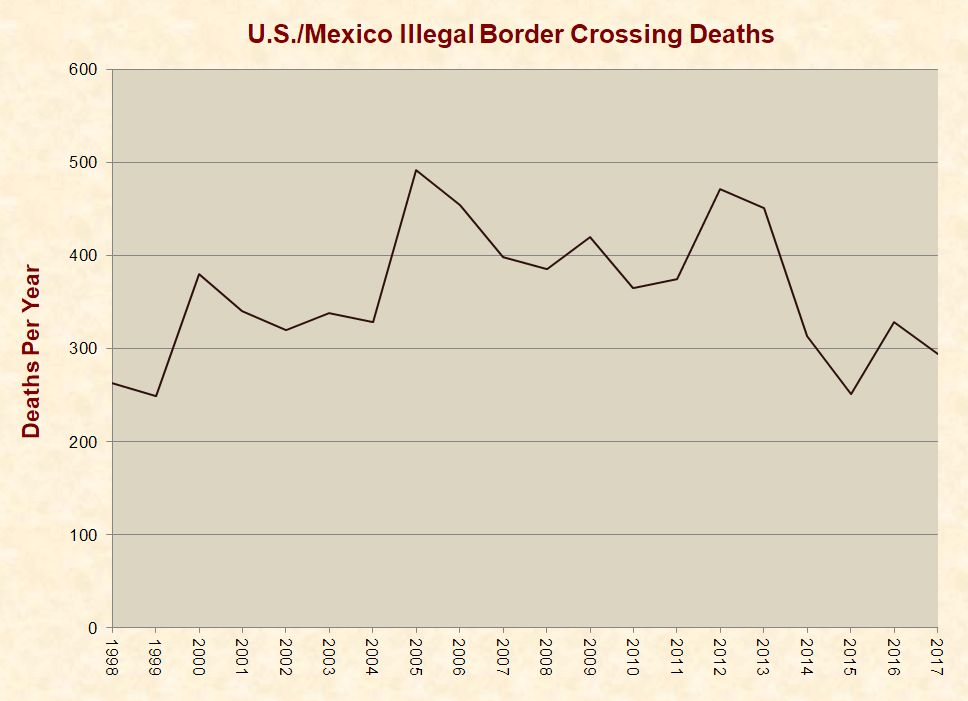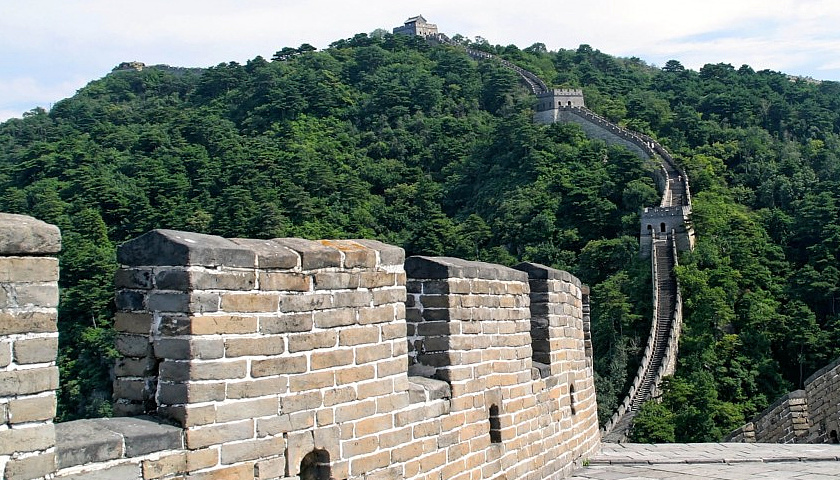by Daniel Marulanda and James D. Agresti
The border between the United States and Mexico stretches for 1,960 miles, parting two major regions of the world with vastly different governments, standards of living, and levels of crime. Consequently, many millions of people have risked their lives to illegally cross the border into the United States. During 2013 to 2015 alone, the U.S. Border Patrol recorded an average of 700,000 illegal entries per year along the U.S.-Mexico border.
Additionally, roughly one million people per year legally immigrate to the U.S., 100 million per year legally visit the U.S., and more than 300,000 per year illegally overstay their visits, often never leaving.
People who illegally enter the U.S. avoid criminal background checks, and as a result, they have much higher serious crime rates than legal immigrants and the general U.S. population. Highlighting the impact of this, a U.S. Government Accountability Office study of 249,000 non-citizens in U.S. prisons and jails during 2003 to 2009 found that they had been arrested for 2.9 million offenses committed within the U.S.—including 69,929 sex offenses and 25,064 homicides. Like most government data, this study did not isolate legal non-citizens from illegal ones, but given that legal immigrants have to undergo background checks, the vast bulk of these criminals were probably in the U.S. illegally.
Mexico is also the primary source of heroin in the United States, where at least 12,989 people died from heroin overdoses in 2015. The actual figure may be significantly higher, because the U.S. Centers for Disease Control and Prevention notes that fatal heroin overdoses are “undercounted by as much as 30 percent” due to inconsistent reporting and difficulties associated with determining the presence of heroin in the bodies of the deceased.
Throughout Donald Trump’s presidential campaign, he repeatedly promised to reduce drug trafficking and violent crimes by illegal immigrants by securing the southern border. His primary idea—to build a wall along much of the border—became his signature pledge. When questioned during a primary debate about whether this plan was realistic, Trump stated, “They built the Great Wall of China. That’s 13,000 miles. Here, we actually only need 1,000 because we have natural barriers.”
However, prominent Democrats have repeatedly lambasted Trump’s plan as antiquated and worthless. For example:
- Senate Democratic Leader Chuck Schumer stated, “A wall can be tunneled under. I’m sure those who love the wall have heard of shovels. It’s a medieval solution for a modern problem.”
- House Democratic Leader Nancy Pelosi wrote, “Make no mistake: the President said he will purposefully hurt American communities to force American taxpayers to fund an immoral, ineffective and expensive border wall.”
- Senate Democratic Whip Dick Durbin stated, “Dreamers should not be held hostage to President Trump’s crusade to tear families apart and waste billions of American tax dollars on an ineffective wall.”
- S. Senator Dianne Feinstein wrote, “Instead of wasting scarce resources on a wall that will be ineffective, we should focus on real solutions.”
Analyzed objectively, those arguments do not stand up to scrutiny.
Far from being relics of a distant age, a wide variety of nations have built, fortified, or expanded border barriers since 2010. This includes Austria, Kenya, Jordan, Spain, Greece, Norway, Slovenia, Macedonia, Gibraltar, Myanmar, Latvia, Lithuania, Estonia, Oman, Algeria, Ukraine, Tunisia, Hungary, and Morocco.
Contrary to arguments that border barriers are ineffective if people ever climb over them, tunnel beneath them, or go around them, the purpose of such barriers is not to stop all illegal cross-border activities—but to stem the tide of them. Per a 2017 report by the U.S. Government Accountability Office:
- “According to Border Patrol officials, pedestrian fencing is intended to divert illegal entrants—which include migrants and criminal organizations that engage in illicit cross-border activities—to areas of the border where agents can … interdict illicit cross-border activities more effectively.”
- “In addition to diverting illicit cross-border activities into more rural and remote environments, pedestrian fencing is intended to serve as a physical barrier that impedes and slows the progress of illegal entrants who attempt to cross the border, and in doing so, provides Border Patrol agents assigned to these areas additional time and opportunities to execute their METs [Mission Essential Tasks], which include detecting, responding, and resolving illicit cross-border activities.
The same report documents that border barriers seem to be effective in accomplishing those goals. Citing Border Patrol officials, the report states that:
- after replacing old fencing with modern pedestrian fencing near Nogales, Arizona, assaults on Border Patrol agents fell from 376 in 2010/2011 to 71 in 2012/2013, “a decline of 81 percent.”
- new pedestrian fencing in urban regions of El Paso, Texas, “has assisted in improving agents’ ability to execute their METs, resulting in higher apprehension rates in these areas.”
- after vehicle fencing near Tucson, Arizona was installed to reduce “large amounts of illegal narcotics transported by motorized vehicles,” “drive throughs dropped by an average of 73 percent.”
While those reductions in illegal activity are substantial, it is important to realize that association does not prove causation— and these declines may have been caused by factors other than the fencing, such as increased border patrols or fluctuating immigration levels. However, as documented below, similar reductions in cross-border crimes have occurred in other nations that have deployed border barriers, and several facts indicate that the barriers were a primary cause of these reductions.
Hungary
 In 2015, hundreds of thousands of refugees from the Middle East and Africa were illegally entering Hungary to seek asylum in Western Europe. In response, the Hungarian government constructed a barbed wire fence along its border with Croatia. Hungary completed the fence and closed this border to illegal migration on October 16, 2015. Within two days—according to data from the Hungarian national police—migrant captures, which is a proxy for arrivals, declined by more than 99% and stayed at this level through the rest of the year:
In 2015, hundreds of thousands of refugees from the Middle East and Africa were illegally entering Hungary to seek asylum in Western Europe. In response, the Hungarian government constructed a barbed wire fence along its border with Croatia. Hungary completed the fence and closed this border to illegal migration on October 16, 2015. Within two days—according to data from the Hungarian national police—migrant captures, which is a proxy for arrivals, declined by more than 99% and stayed at this level through the rest of the year:
The timing and abruptness of this decline suggest that the fence played a major role in it.
Israel
Another case study on the effectiveness of border barriers is found in Israel. Per Israeli government data published in a 2017 report from the Republican members of the Senate Committee on Homeland Security & Governmental Affairs:
- Israel began constructing a fence along its border with Egypt in 2010 to stem an “increasingly uncontrolled flow of migrants from Africa.”
- These migrants have a strong incentive to enter Israel, because they “can earn a year’s worth of salary” in their “home country by working two days in Israel.”
- The fence took about two years to complete.
- In the years surrounding the completion of the fence in 2012, recorded illegal entries were as follows:
 The same report notes that the small uptick in 2015 occurred “because crossers began to use ladders at a section of the border to defeat the fence. To address this tactic, Israel increased the height of the fence, rendering the ladders ineffective.” This shows how barriers can be improved to defeat challenges to them.
The same report notes that the small uptick in 2015 occurred “because crossers began to use ladders at a section of the border to defeat the fence. To address this tactic, Israel increased the height of the fence, rendering the ladders ineffective.” This shows how barriers can be improved to defeat challenges to them.
The facts surrounding another Israeli border barrier are even more significant, because the barrier has life-or-death stakes and is meant to keep out people who are extremely motivated to get in. In the fall of 2000, peace negotiations between the Israelis and Palestinians organized by Bill Clinton fell apart, and Palestinian terrorists soon began killing Israelis in record numbers. Between late 2000 and 2003, more than 900 civilians, soldiers, and government workers in Israel were murdered in attacks carried out by Palestinians. Thousands more were injured or maimed. These massacres often took the form of suicide bombings in public places like restaurants, buses, and shopping malls.
This surge of terrorism prompted Israel to rapidly begin constructing a multilayer system of fences and walls known as the “West Bank Barrier” in 2002. Almost immediately, the number of Israeli civilians killed by Palestinians in Israel began plummeting and has stayed at greatly reduced levels ever since:
 Other factors played a role in this decline, such as Israel’s Operation Defensive Shield, but some key Palestinians have explicitly stated that this barrier restricts their ability to conduct suicide bombings:
Other factors played a role in this decline, such as Israel’s Operation Defensive Shield, but some key Palestinians have explicitly stated that this barrier restricts their ability to conduct suicide bombings:
- In 2007, Hamas official Mousa Abu Marzouq was asked why suicide bombings had declined since Hamas rose to power. He replied that carrying out “such attacks is made difficult by the security fence and the gates surrounding West Bank residents.”
- In 2008, Palestinian Islamic Jihad leader Ramadan Abdallah Shalah stated that the Israeli West Bank fence “limits the ability of the resistance to arrive deep within [Israeli territory] to carry out suicide bombing attacks….”
The direct nature of this evidence leaves virtually no doubt that this border barrier has been effective.
Flawed Analyses
Several media outlets and think tanks have published flawed and generally negative analyses on the value of border barriers. Some of the failings they suffer from are exposed below.
The Migration Policy Institute claims that border “walls are relatively ineffective,” because even though many barriers have been constructed in recent years, “millions of people globally continue to cross borders without authorization.” This only shows that barriers deployed by some countries have not completely stopped worldwide illegal immigration. It does not prove whether or not border walls have been effective.
New York Times reporter Isabel Kershner claims that “several other important factors” besides the West Bank Barrier are responsible for the “sharp decline in the number and scope of terrorist attacks by West Bank Palestinians in Israel.” Among these, she says: “As the second Palestinian intifada, or uprising, waned around 2004, Hamas, the militant group that now controls Gaza, put a moratorium on suicide bombings.” Kershner provided no hyperlink or other evidence to document this claim. Contradicting her point, the Israel Ministry of Foreign Affairs lists two suicide bombings on January 18, 2005 and August 28, 2005 carried out by Hamas.
In reply to an email from Just Facts, Kershner pointed to a 2006 article citing Hamas activists who said the group will “abandon its use of suicide bombers,” but this was after Palestinian killings of Israeli citizens had already plummeted. Furthermore, Kershner herself reported that “the military wing of Hamas officially claimed responsibility for” a suicide bombing in February 2008 at a shopping center in Israel. The same article states that Hamas spokesman Abu Zuhri “said that Hamas had never declared a complete end to suicide missions, and that the lulls it had offered ‘were not respected’ by Israel.”
In sum, the evidence does not support the belief that a decision by Hamas to stop suicide bombings played an “important” role in reducing the deaths of Israeli citizens. If anything, the facts suggest that Hamas cut back on suicide bombings because the West Bank Barrier made them difficult to carry out. As detailed above, this is precisely what Hamas official Mousa Abu Marzouq said in 2007.
 The final example of a flawed analysis comes from U.S. News & World Report staff writer Lauren Fox, who claims that increased border security in the U.S. has “forced” migrants “to take more treacherous routes through remote areas, resulting in a spike in migrant deaths.” She does not specify a timeframe for this alleged spike, and data from as far back as the U.S. Border Patrol provides shows no systematic trends in the number of people who have died while illegally crossing the U.S.-Mexico border:
The final example of a flawed analysis comes from U.S. News & World Report staff writer Lauren Fox, who claims that increased border security in the U.S. has “forced” migrants “to take more treacherous routes through remote areas, resulting in a spike in migrant deaths.” She does not specify a timeframe for this alleged spike, and data from as far back as the U.S. Border Patrol provides shows no systematic trends in the number of people who have died while illegally crossing the U.S.-Mexico border:
While some people who are considering illegal immigration react to tighter border security by taking more dangerous paths, others respond by choosing not to make the trip at all. The net effects of these choices on deaths is unknown. However, formidable and comprehensive border security—as Trump has proposed—provides a strong disincentive to such crime. Thus, Trump’s wall may actually reduce deaths from illegal border crossings.
Summary
Democratic Party and media attacks on President Trump’s border wall are not grounded in objective reality. Far from being outdated and useless, border barriers are a modern and seemingly effective means to prevent illegal cross-border activity. They do not stop all of it, but that is not their purpose. Their purpose is to significantly curtail such crime, and they appear to do this well. While most of the evidence surrounding this issue does not allow for conclusions with 100% certainty, the weight of it suggests that border barriers accomplish their goals.






Several media outlets and think tanks have published flawed and generally negative analyses on the value of border barriers. Some of the failings they suffer from are exposed below.
Wait a minute! This cannot be true. Everyone knows it is Republicans in fly-over country that is responsible for continuing and even increasing COVID infections.
We all know that the magic Democrat wall at our U.S. southern border has an automatic sterilizing agent that assures no Covid virus gets across to the American side. A 900% increase in illegal alien border crossing with stop and release in effect, has nothing to do with it.